________________
YĀTUMĀVANT
By M. A. MEHENDALE, Poona
The word yātumā'vant is attested only in the Rgveda where it occurs four times (1.36.20, 7.1.5, 7.104.23, and 8.60.20). According to the dictionaries yātuma'vant is identical in meaning with yātumánt practising witchcraft or sorcery': • Th. BENFEY! (Orient und Occident 1, 1862, p. 387 note 328) rejects Sáyaņa's explanation of this form and proposes to take mävant as an 'organischere Form' of māvan, the latter coming from the verb V man and the suffix -van. GRASSMANN Wörterbuch, under stavát) regards -mävat as a double secondary suffix arising out of -man-vant with the loss of n and the consequent lengthening of the preceding vowel a (cf. WACKERNAGEL I S 42). H. H. BENDER (The Suffixes mant and vant in Sanskrit and Avestan, Baltimore, 1910) considers (p. 59) the formation of the word unclear, but looks upon the suggestion of GRASSMANN as plausible, if not convincing. Later on p. 81, f. n. 2 he seems to accept GRASSMANN's suggestion. Louis H. GRAY (Anzeiger für Indo-germanische Sprach- und Altertumskunde 30, p. 9, 1912) also considers the derivation of yátumä'vant < * yātu-manvant as correct. WACKERNAGEL-DEBRUNNER seem to give two different explanations of this form. In Alt. Gr. II, 2 & 620 they say that yātu-ma'vant is only a Vedic variant for yåtu-mánt used to obtain a metrically agreeable end of a pāda. But in $ 713 b8 they cite it under "Stammerweiterungen" and appear to regard yātu-má- as an extended base to which is added the suffix -vant. Since they do not give any explanation of the extended base, it is not clear whether they approve of GRASSMANN's suggestion or reject it and have some other explanation in mind (see below).
Sāyaṇa appears to offer three different explanations of the form. While commenting on RV 1.36.20, where the word occurs for the first time, he takes only -vant as the possessive suffix, and explains the stem yātumaas coming from yātu + V ma? meaning 'activities of demons' (yatavo
1. I am greatly indebted to Prof. W. Wüst for sending to me BENFEY's opinion on this expression as well as for giving me the reference to GRAY's opinion referred to below.
2. I do not understand how BENDER (p. 59) says that "Sāyana derives yätumā'vant from yātu-ama and the secondary suffix vant."
Madhu Vidya/17
Jain Education International
For Private & Personal Use Only
www.jainelibrary.org




